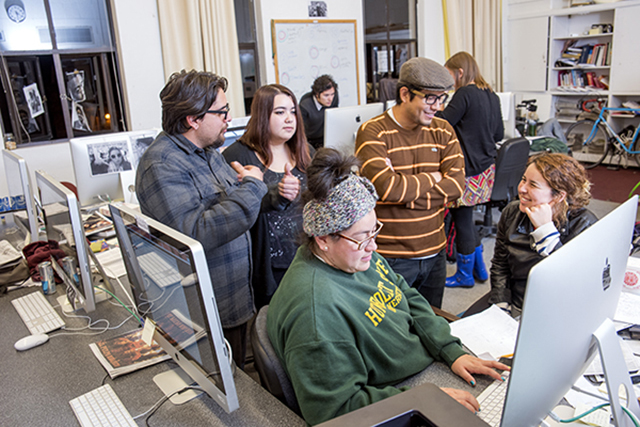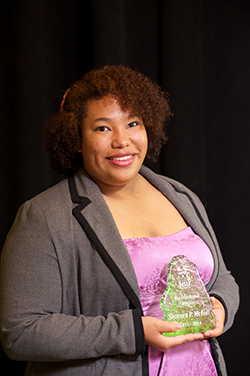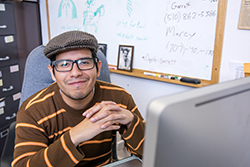
With the backing of faculty members, the project came to fruition in the form of the monthly publication _El Leñador_. Since the first issue went to press in May of 2013, _El Leñador_ has continued to evolve, recently gaining independent status and separating from HSU’s student newspaper, _The Lumberjack_.
In the 1½ years since that first issue, the newspaper has developed an identity that achieves a balance of opinion and objective reporting. Along with reporting news of specific importance to their readership, _El Leñador’s_ writers thrust themselves into topics, offering a variety of voices.

One benefit of standing on its own is the potential of wider distribution to targeted areas of Humboldt County. Offering the first Spanish language articles since the demise of _El Heraldo_, a local newspaper that published from 1998-2010, _El Leñador_ will soon be available in areas with more prominent Latino populations, including Fortuna and parts of Eureka.
Key to that expansion has been the involvement of Editor-in-Chief Manuel J. Orbegozo, who not only organizes and edits the content, but is also the force behind the expansion efforts. An accomplished photojournalist who came to the United States and HSU from his home country of Peru, he’s also responsible for directing staff members who are studying a variety of academic disciplines, and working with other contributors.
“People are excited about writing for our publication because they can produce stories they’re able to connect with, personally,” Orbegozo said. “They’re motivated to go out and do well-developed stories and embrace the overall objective of making the publication professional. They know this community wants a well-structured newspaper. They want to contribute to a medium that allows them to feel that their voice is important.”

That importance was well illustrated in a series of stories on undocumented citizens that ran in fall editions. The articles helped spread awareness of the services provided by the local Promator@s, a subcommittee of the Latino Community Provider Network.
Workshops explaining the AB 60 law that allows undocumented people to apply for driver’s licenses were detailed in the first installment, and the arrival in Humboldt County of lawyers that can help those same citizens regulate their papers was addressed in the next.
“These articles were written in Spanish, because they were mostly focused on a Latino/a population that feels more comfortable reading in that language, thus making it more accessible,” Orbegozo said. “Promotor@s have been very receptive and nice to us and they let me, the editor in chief, attend their meetings so I can stay up to date with community events. They understand the importance of a newspaper for the Latino community and we value their trust in us to be that medium.”
_El Leñador’s_ roots can be traced to a 2007 interaction between Marcy Burstiner, chair of the Department of Journalism & Mass Communication, and a Latina student enrolled in Burstiner’s Beginning Reporting class.
“She had taken my Beginning Reporting class and had done so well I tried to get her onto the staff of the Lumberjack,” Burstiner said. “But she said she really wanted to report and write in Spanish. I felt terrible that we didn't have that opportunity for her.”
When news came of HSU’s pending status as a Hispanic Serving Institution, a designation reserved for universities with at least 25 percent undergraduate Latino enrollment, Burstiner felt the time was right to address the concern. She partnered with Rosamel Benavides-Garb, chair of the Department of World Languages & Cultures, on a plan to move forward.
Together, the faculty members secured a faculty-student collaboration grant from the College of Arts, Humanities & Social Sciences, funding six stipends that allowed a student committee to begin examining the possibilities. When McFall heard about the opportunity, she was quick to volunteer.
“I wanted to help with the project because I saw the importance to Latino students and community to have a forum to express themselves,” McFall said. “Once the group was chosen we had to get organized, but no one knew where to start.
“For about two weeks I stayed in the background and listened to what the other students had to say, but then realizing that we would get nowhere without some kind of structure, I decided to take initiative to organize the research, delegate tasks, and remind people of what they had to bring to every meeting.”
With the project taking shape, Burstiner and McFall worked together to acquire more grant funding from the Office of Diversity & Inclusion, including $3,780 of alumni gifts from the Humboldt Loyalty Fund, which supports student scholarships, research, academic programs, and other special projects. That support covered the 2013 pilot issue and another year’s publication of monthly editions.
Also key to a successful launch was the involvement of Juan Carlos de la Cruz, a 2012 HSU graduate with a bachelor’s degree in Spanish Education. Assuming the role of head translator while also working as a writer, de la Cruz worked on accuracy, grammar, and spelling to assure a professional, high quality product. Following a brief break, de la Cruz has returned to the project in his previous capacity while pursuing his secondary teaching credential, and has also assumed a new beat as a reporter.
“I cover the Latin America news beat—what’s going on in Spanish-speaking countries,” de la Cruz said. “There’s a need for our audience to be aware of what’s going on in the world beyond Humboldt.”
For the paper to survive independently, it will have to develop an ad sales component and incorporate more business planning. But even as a self-sustaining project, Burstiner believes it still has great potential for academic purposes.
“I see _El Leñador_ as an eventual anchor to a bilingual journalism minor,” she said. “Students would take two journalism classes, two Spanish language classes, and _El Leñador_.”